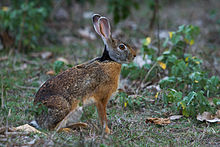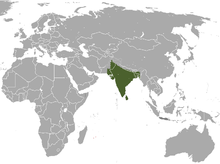Indian hare
| Indian hare | |
|---|---|

| |
| Scientific classification | |
| Domain: | Eukaryota |
| Kingdom: | Animalia |
| Phylum: | Chordata |
| Class: | Mammalia |
| Order: | Lagomorpha |
| Family: | Leporidae |
| Genus: | Lepus |
| Species: | L. nigricollis[1]
|
| Binomial name | |
| Lepus nigricollis[1] F. Cuvier, 1823
| |

| |
| Indian hare range (green – native, red – introduced, dark grey – origin uncertain) | |
The Indian hare (Lepus nigricollis), also known as the black-naped hare, is a common species of hare native to the Indian subcontinent,[3] and Java. Its habitat in Java is in rocky highlands.
Description
The weight of an adult Indian hare can reach 6 kg. Its body length can reach 40 cm. Its hair color is yellowish brown. Indian hares can live 5 to 10 years, and can become pregnant 7 times a year, with an average number of 6 to 12 cubs. Indian hares are relatively more immune to various diseases because they have adapted to a tropical climate, and they reproduce very quickly compared to imported rabbits. Indian hares are relatively small in size and don't have very thick fur.
Introductions

It has been introduced to Madagascar, Comoro Islands, Andaman Islands, Western New Guinea, Papua New Guinea, Seychelles, Mayotte, Mauritius and Réunion.[4]
Taxonomy
There are seven recognized subspecies of Indian hare.
- Lepus nigricollis aryabertensis
- Lepus nigricollis dayanus
- Lepus nigricollis nigricollis
- Lepus nigricollis ruficaudatus
- Lepus nigricollis sadiya
- Lepus nigricollis simcoxi
- Lepus nigricollis singhala
References
- OCLC 62265494.
- . Retrieved 18 February 2022.
- doi:10.1078/1616-5047-115. Archived from the original(PDF) on 2016-03-03. Retrieved 2006-06-12.
- ISBN 9780851997483.

